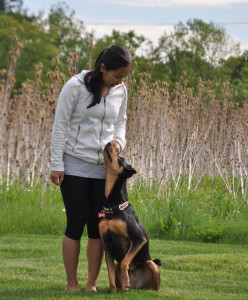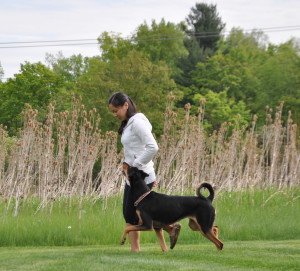Building a Foundation

You can’t learn calculus without first learning algebra.
Loose leash walking follows the same rules. A beautifully focused dog voluntarily loose-leash walking is the same as a dog performing calculus. In order to tune out distractions, stay focused, and control herself, a dog needs have strong impulse control and handler focus. She needs to have learned basic algebra before we can expect her to learn calculus.
Fortunately, teaching a dog to walk on a loose leash in the most effective and humane way doesn’t require as much mental effort as teaching a student calculus – well, unless, you’re a math genius. For the rest of us, loose leash walking can be pared down to a simple training exercise: what I call, the “Automatic Sit”.
Imagine: your dog voluntarily plops into an automatic sit whenever she wants something – food, toys, to put on her leash, to go for a walk, etc. And she does it all without any verbal cues. That’s an automatic sit. It’s the simple and powerful foundation to loose leash walking.
To teach this automatic sit, begin by holding a treat above your dog’s nose. Don’t say anything. Grasp the treat firmly and do not give even a small piece. Then, once you see her drop her rear or plop into a sit, say “Yes!” (or use a clicker) and reward with the treat. Wash rinse repeat.

Once your dog consistently and immediately plops into sits as if asking “Please, may I have the treat?”, place your dog on a leash. Take several brisk steps backwards and then suddenly stop. Avoid confusing cues (i.e. be careful with your hands), and don’t say a word! Ideally, your dog will wonder what just happened and plop into a Sit to earn the treat. If she struggles with this, hold the treat just above her nose to remind her that there’s something great to work towards. Wash rinse repeat. Now, once your dog is sticking to you like glue and immediately plopping into a sit when you stop, guide your dog to your left side and perform the same exercise – except, this time, your dog is on your left. This step is harder for most dogs because, suddenly, the world at large is in front of them instead of just you. Keep practicing, and you’ll both start to get the hang of it. Over time, you’ll be covering a distance from three steps forward to an entire block! And your dog will know that any stop is an indicator to automatically sit and pay attention to you. No verbal cues necessary. It’s the ideal loose leash walk, and it all starts with a very simple exercise: the automatic sit.




Next post, we’ll cover the qualities of a good loose leash walk and how to troubleshoot common errors.
